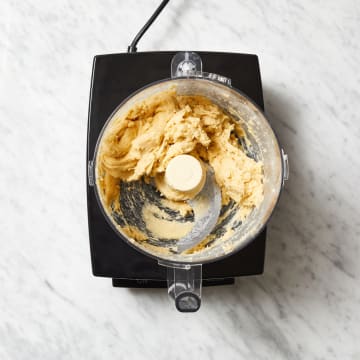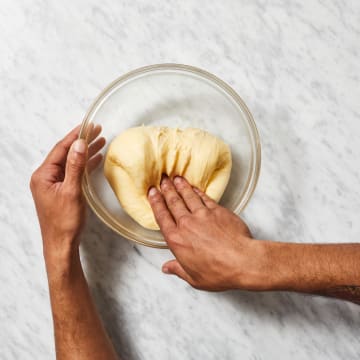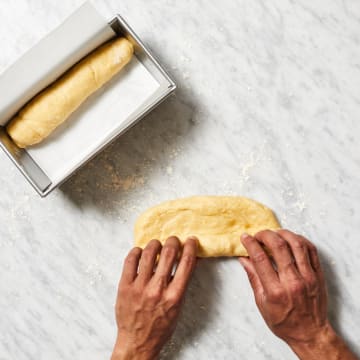Steam-Baked Brioche

Andrew Janjigian
April 5, 2023
This brioche recipe includes a tangzhong (or flour scald), which makes it especially plush and moist, while also slows down staling to keep the loaf fresh longer. The brioche dough is made in a food processor, which makes quick work of it.
The loaf is baked at two temperatures: Ten minutes at 400˚F (204˚C), to encourage rapid oven spring for a tall loaf, followed by another 20 minutes or so at 300˚F (149˚C), to ensure the loaf is cooked through at its core. The Anova Precision Oven will adjust these temperatures automatically. Using the oven for proofing the dough also ensures consistency, no matter the ambient temperature in your kitchen.
It is very important to be sure the loaf is set on the inside, especially with soft, tender brioche, or it can collapse as it cools. So be sure to use a thermometer to check that it is at least 200˚F (93˚C) at its core before you remove it from the oven.
Serves
6
Prep Time
03:20
Cook Time
00:30

5 (1)
530
Ingredients
Tangzhong and Milk Sponge
95 g (6 Tbsp plus 1 tsp)
whole milk, divided
30 g (2 Tbsp plus 1 tsp)
sugar
7 g (1 1/2 tsp)
instant yeast
27 g (3 Tbsp)
bread flour
Dough
2 large
eggs (100g)
245 g (1 3/4 cups)
bread flour
4 g (3/4 tsp)
fine salt
57 g (4 Tbsp)
unsalted butter, cut into 1/2-inch cubes, at room temperature
Egg Wash
1 large
egg (50g)
½ tsp
sugar
¼ tsp
fine salt
¼ tsp
water
Steps
1. Start Tangzhong
In a medium bowl, whisk together 60g of the milk with the sugar and bread flour, then transfer to a small nonstick skillet. In a second small bowl, whisk the remaining 35g milk and yeast together until evenly combined and set aside.

2. Cook Tangzhong
Set the skillet over medium heat and cook, stirring constantly with a silicone spatula, until the mixture comes together in a thick, mashed potato-like paste, about 2 minutes. Remove from the heat, scrape back into the medium bowl, and let cool for 10 minutes.

3. Add Eggs
Add one egg to the bowl with the tangzhong and whisk vigorously until the mixture is smooth, 15 to 30 seconds. Add the second egg and whisk until smooth.

4. Start Dough
Transfer the tangzhong and yeast mixture to the bowl of a food processor; add the flour. Process until the mixture is just combined and no dry flour remains, 15 to 30 seconds. Allow to sit, covered, for 30 minutes.

5. Finish Dough
Add the salt and process until the dough forms a near-uniform ball, about 30 seconds. Scatter the butter over the dough and pulse until the butter is fully incorporated, 8 to 10 pulses, scraping down the sides of the bowl as needed. Continue to process until a webby dough forms, 15 to 30 seconds. (Do not overprocess here; if the dough starts to clump around the blade, stop immediately.)

6. Proof Dough
Rack
Transfer the dough to a lightly oiled medium bowl and, using a flexible dough scraper, gather it into a ball. Cover with plastic wrap. Transfer to the oven and start the cooking stage. Let proof for 45 minutes.
Sous Vide Mode: Off
Steam: Off
Temp: 77°F
Heat: Bottom
00:45 Timer
7. Turn Dough
Using lightly moistened hands, fold the dough over itself by gently lifting and folding the edge of dough toward middle. Turn bowl 90 degrees; fold again. Turn the bowl and fold dough 4 more times, for a total of 6 turns.

8. Finish Proofing
Rack
Cover bowl with plastic wrap and return to the oven. Let proof until risen by about half, 45 to 75 minutes.
Sous Vide Mode: Off
Steam: Off
Temp: 77°F
Heat: Bottom
00:45 Timer
9. Preshape Dough
Transfer the dough to a lightly floured counter and divide into two pieces of equal weight (about 260g each). Gently press each piece into a 5-inch-long rectangle.
Starting at one long side of the rectangle, roll each into a log about 6 inches long by 1 inch wide. (Take care not to incorporate air bubbles in the center of the logs by rolling them gently from the center toward the ends.)
Cover the logs loosely with plastic wrap and let sit for 15 minutes.
10. Shape Loaf
Cut a sheet of parchment paper to fit snugly the short way across an 8.5- by 4.5-inch-ish loaf pan with at least 2 inches of overhang on both sides. Fold the paper so that it sits cleanly in the pan, then set it aside. Lightly grease the inside of the pan, then set the parchment sling in place.
Using a bench scraper, loosen the logs from countertop if necessary. Flour the countertop and logs lightly. Gently press each log into a rectangle, then, starting at one long side of the rectangle, roll into a log 7 to 8 inches long by 1 inch wide. (Take care not to incorporate air bubbles in the center of the logs by rolling them gently from the center toward the ends.) Set each log side by side in the pan.

11. Proof Loaf
Rack
Cover the pan loosely with plastic wrap and return to the oven to proof until the logs have merged and the dough has just passed the top edge of the pan, 90 to 120 minutes. Remove from the oven.
Sous Vide Mode: Off
Steam: Off
Temp: 77°F
Heat: Bottom
01:30 Timer
12. Adjust the Oven for Baking
Rack
Sous Vide Mode: Off
Steam: 10%
Temp: 400°F
Heat: Rear
13. Make Egg Wash
Place the egg, sugar, salt, and water in a small bowl and whisk until uniform.
14. Start Baking
Rack
Coat the exposed surfaces of loaf with the egg wash, transfer to the oven, and bake for 10 minutes.

Sous Vide Mode: Off
Steam: 10%
Temp: 400°F
Heat: Rear
00:10 Timer
15. Let the Oven Adjust to Finish Baking
Rack
Let the oven automatically reduce temperature and continue to bake until the center of the loaf registers at least 200˚F (93˚C) with an instant-read thermometer, 20 to 30 minutes.

Sous Vide Mode: Off
Steam: 10%
Temp: 300°F
Heat: Rear
00:20 Timer
16. Cool
Transfer the loaf to a rack and let cool in the pan for 5 minutes. Remove the loaf from the pan and return to the rack to cool completely, 1 to 2 hours. Slice and serve.
© 2013 - 2026 Anova Applied Electronics, Inc.